Sometimes, a big team will have an off day and drop points.
Sometimes, that team drops points due to misfortune or bad luck.
On other occasions, they’re outclassed on the day — this is what happened when Barcelona met Real Sociedad this past weekend and dropped their second set of three points in La Liga this season at Reale Arena.
Txuri-urdin ended the game as 1-0 winners, having taken 13 shots to Barca’s 10.
Crucially, six of Real Sociedad’s shots were on target to Barcelona’s resounding zero.
This tactical analysis
aims to highlight Imanol Alguacil’s tactics behind Txuri-urdin’s victory over Barcelona. We will focus on Imanol Alguacil’s high-pressing approach and how it greatly disturbed Hansi Flick’s side’s rhythm.
Real Sociedad Vs Barcelona Lineups
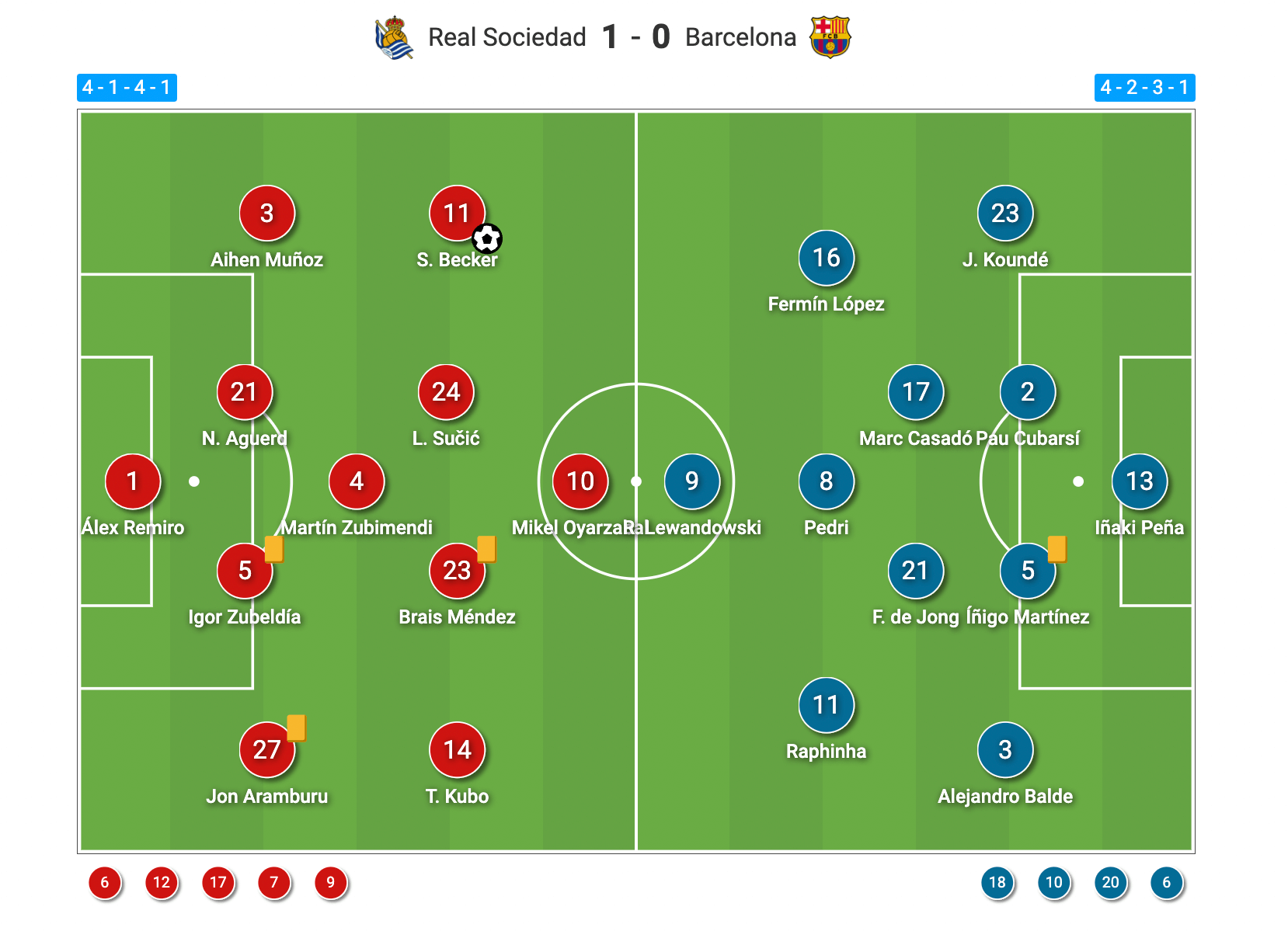
Firstly, let’s go through both teams’ respective starting XI on Sunday.
Imanol Alguacil’s Real Sociedad Formation
Hosts Real Sociedad lined up in a base 4-1-4-1 shape with Álex Remiro between the sticks behind right-back Jon Aramburu, right centre-back Igor Zubeldía, left centre-back Nayef Aguerd and left-back Aihen Muñoz.
Martin Zubimendi played as the holding midfielder behind a central midfield pairing of Brais Méndez and Luka Sučić.
Takefusa Kubo started on the right, opposite Sheraldo Becker on the left while Mikel Oyarzabal led the line up top.
Alguacil made five substitutions during the game, four of which occurred simultaneously in the 61st minute.
Aritz Elustondo came on for Aramburu, Ander Barrenetxea replaced Becker, Sergio Gómez was introduced in place of Sučić and Orri Óskarsson took over from Oyarzabal up front.
Real Sociedad’s fifth and final change came in the 84th minute as Javi López entered the field for Muñoz.
Hansi Flick’s Barcelona Formation
On the other side, Hansi Flick’s formation set his team up in a 4-2-3-1 base shape with Iñaki Peña starting in goal, Jules Koundé at right-back, Pau Cubarsí at right centre-back, Íñigo Martínez at left centre-back and Alejandro Balde at left-back.
Marc Casadó and Frenkie de Jong made up the midfield behind attacking midfielder Pedri, right-winger Fermín López and left-winger Raphinha, while Robert Lewandowski led the line.
Barca made four substitutions over the course of this match.
Firstly, Dani Olmo came on for De Jong at half-time.
Then, in the 69th minute, Ansu Fati was introduced for López.
In the 84th minute, Gavi entered the game in place of Koundé before Blaugrana made their final change in the first minute of stoppage time as Pau Víctor replaced Pedri.
Imanol Alguacil’s High Press
High pressing is a critical component of Imanol Alguacil’s coaching style at Real Sociedad.
This season, the Basque club have the lowest PPDA (indicating the highest pressing intensity) of any team in Spain’s top flight — one of only two teams, along with Rayo Vallecano, to press more aggressively than Flick’s side.
They ended this game with a PPDA of 10.76, marginally lower than Barca’s 10.89.
Real Sociedad High Regains Map
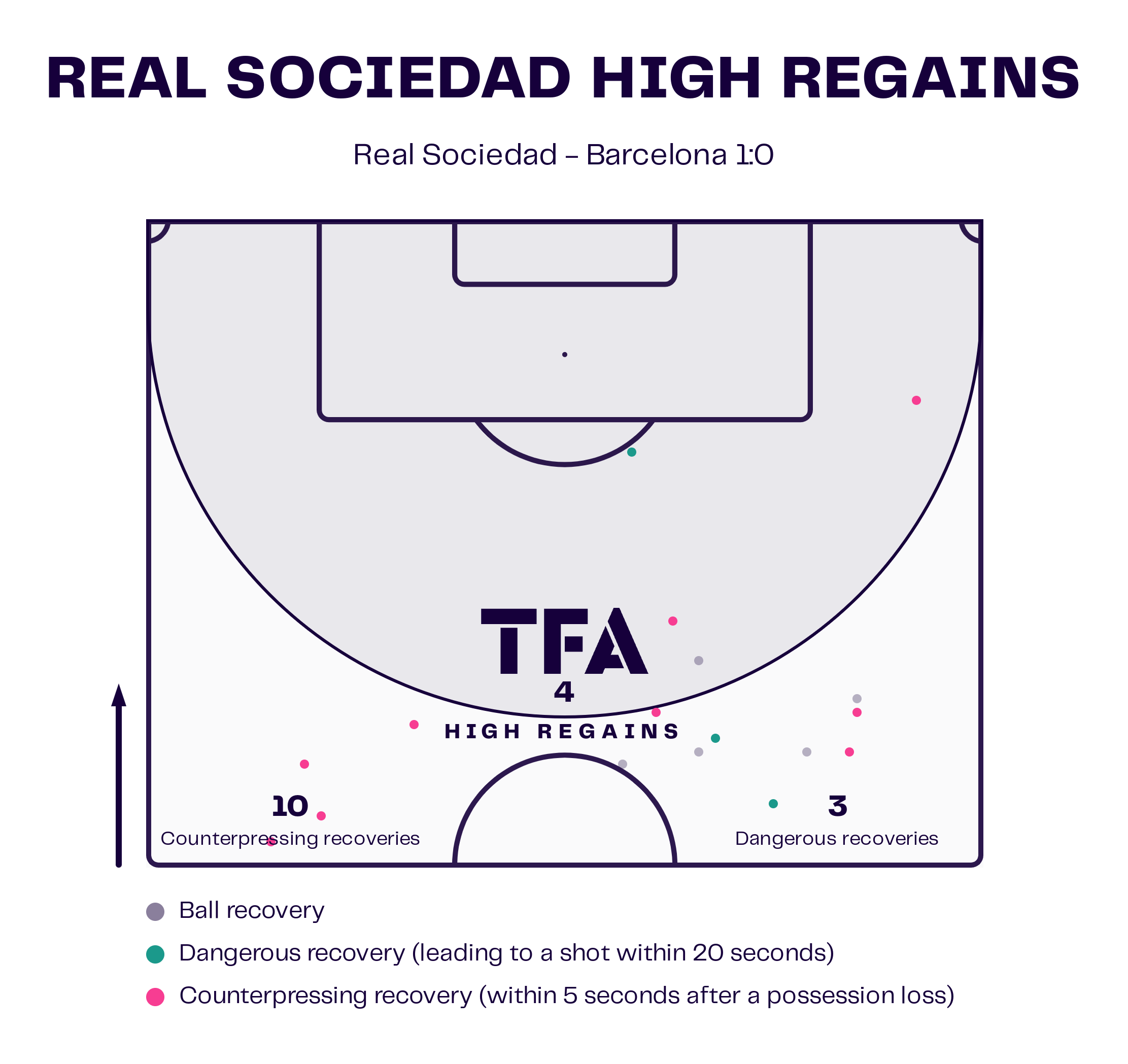
As Figure 2 shows, Sociedad’s high press successfully helped the team generate a few chances on goal.
Their high press also continuously disrupted Barca’s build-up, preventing the Catalan side from being able to progress play from their own half on a consistent basis.
Flick’s side ended Sunday’s game with a pass accuracy rate of 86.57% — lower than their 2024/25 average of 88.3% in all competitions, equal with the pass accuracy rate Barca finished with against Vincent Kompany’s FC Bayern in the UEFA Champions League in October.
Barcelona’s shot total in Sunday’s game (10) was also well below their season average of 14.05.
Meanwhile, Sociedad became just the second team to limit Barca to generating less than one expected goal on Sunday
. The Catalan side finished with an xG of just 0.96—their second-lowest total of the 2024/25 campaign in all competitions, trailing only the total they accumulated versus AS Monaco (0.27)—another game Barca lost.
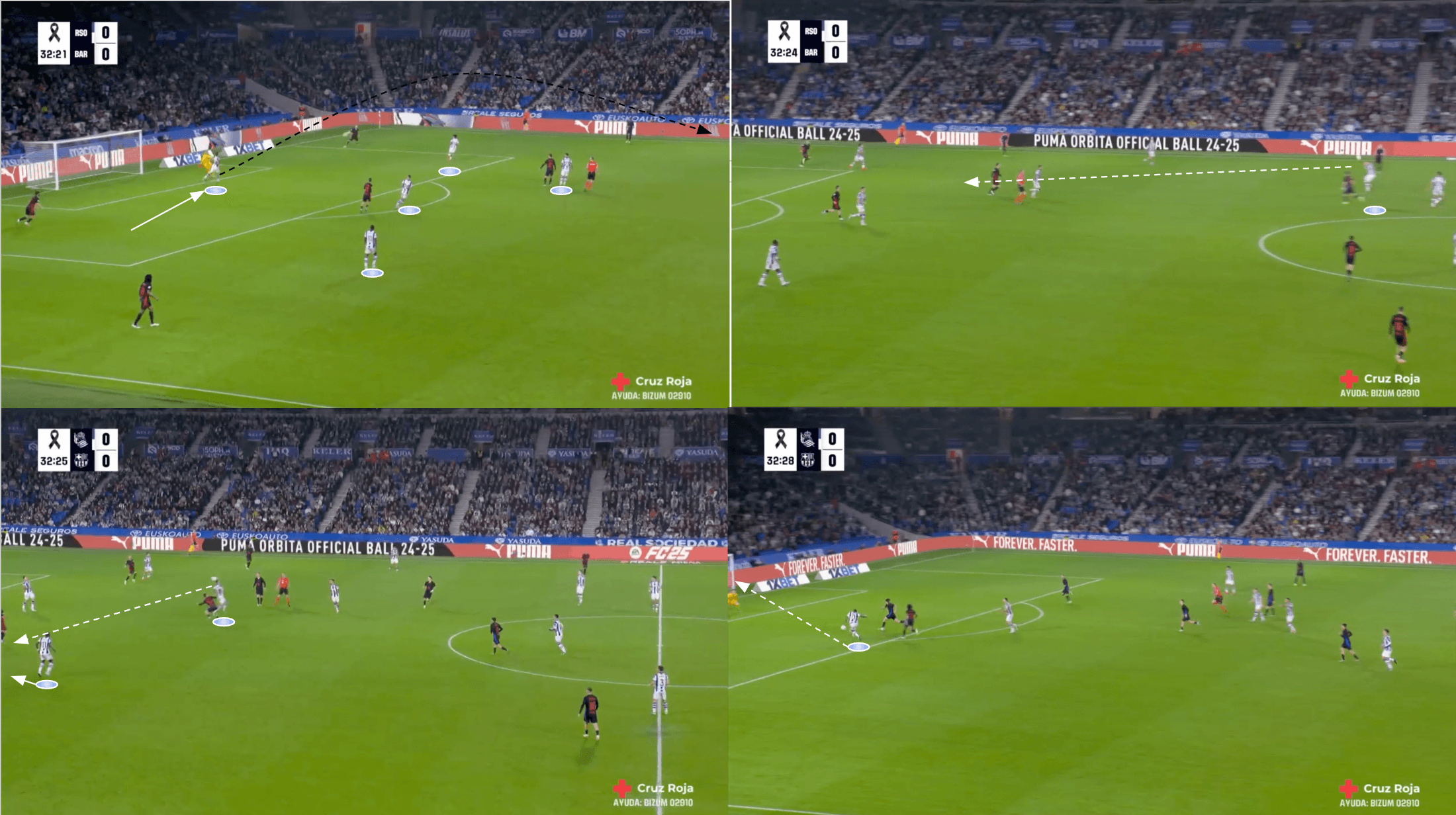
Sociedad’s high press was instrumental in creating the only goal of the game.
In the top-left image above, we can see how high and aggressive Sociedad pressed Barca right from the Catalan side’s goal kicks.
After the goalkeeper is forced to send the ball long after coming under immense pressure from Oyarzabal and with the nearest passing options also being marked closely, a Sociedad defender heads the ball back into danger.
The ball is then flicked on into goalscorer Becker’s path by Sučić, putting the Basque team in the lead in the 33rd minute of the game.
This provides an example of how the high press was vital to disrupting Barca’s build-up play and creating chances for Sociedad on Sunday.
Real Sociedad’s Aggressive Forwards
One important aspect of Real Sociedad’s high press was the way in which their base 4-1-4-1 shape typically became a 4-1-3-2 as Kubo joined Oyarzabal in the forward line, eliminating Barca’s +1 numerical superiority in the first line.
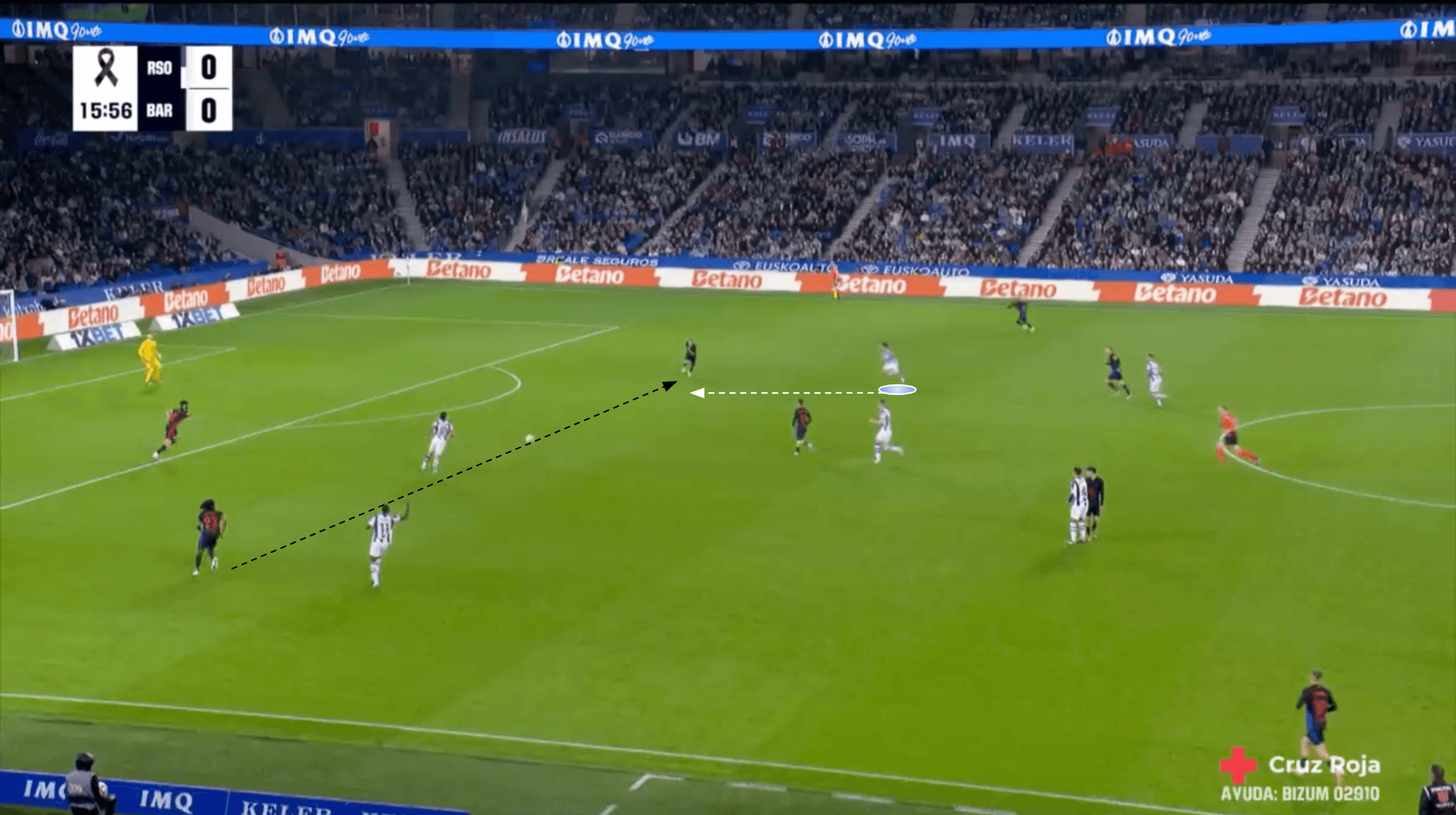
In Figure 4, we see Kubo joining Oyarzabal in the forward line and directly applying pressure to Barca’s central defensive duo.
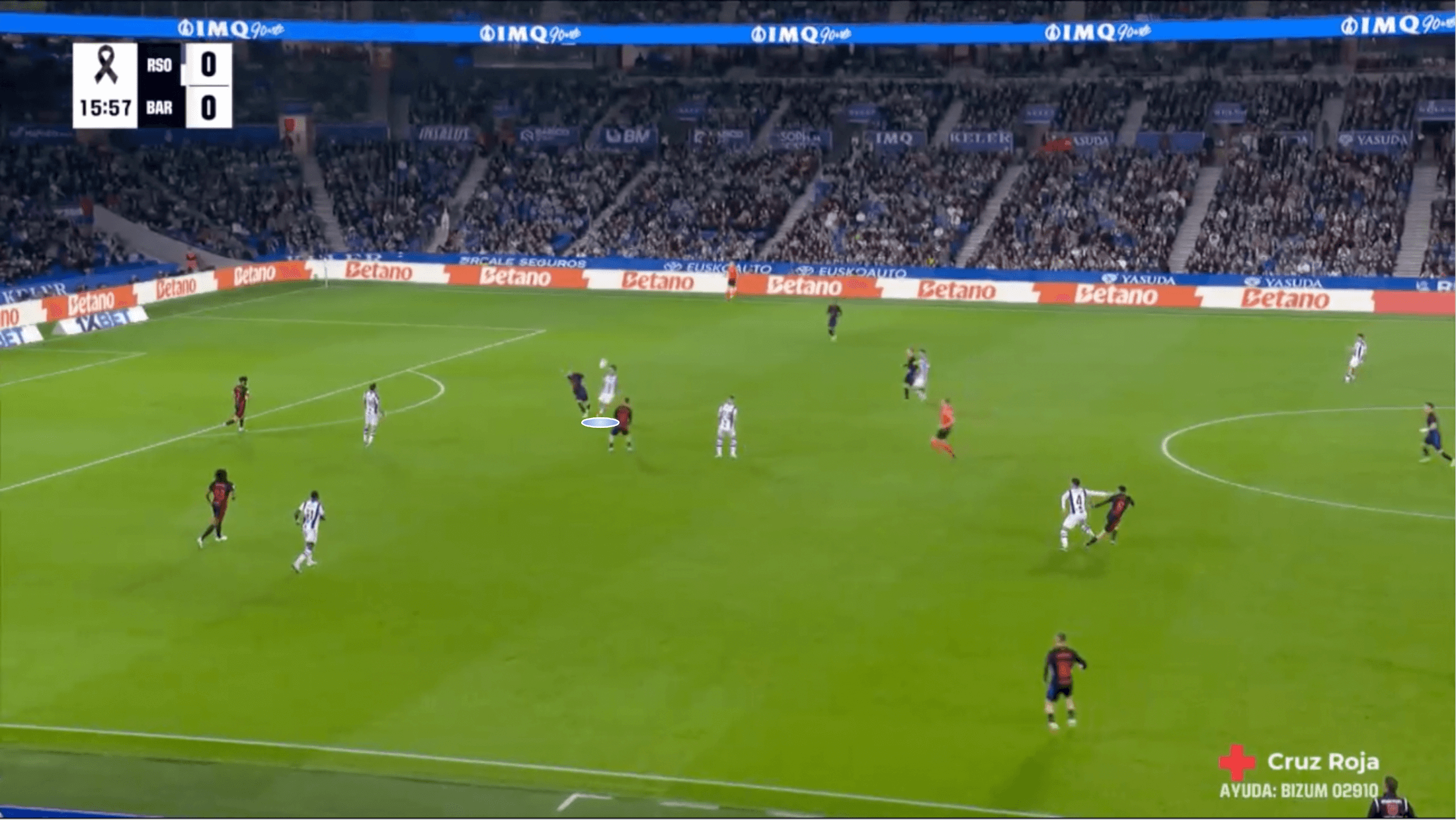
Immediately as left centre-back Martínez receives, he’s under pressure from Kubo.
This pressure pushes Martínez into a rushed move—a long ball directed forward, which Sociedad’s centre-back ultimately wins aerially.
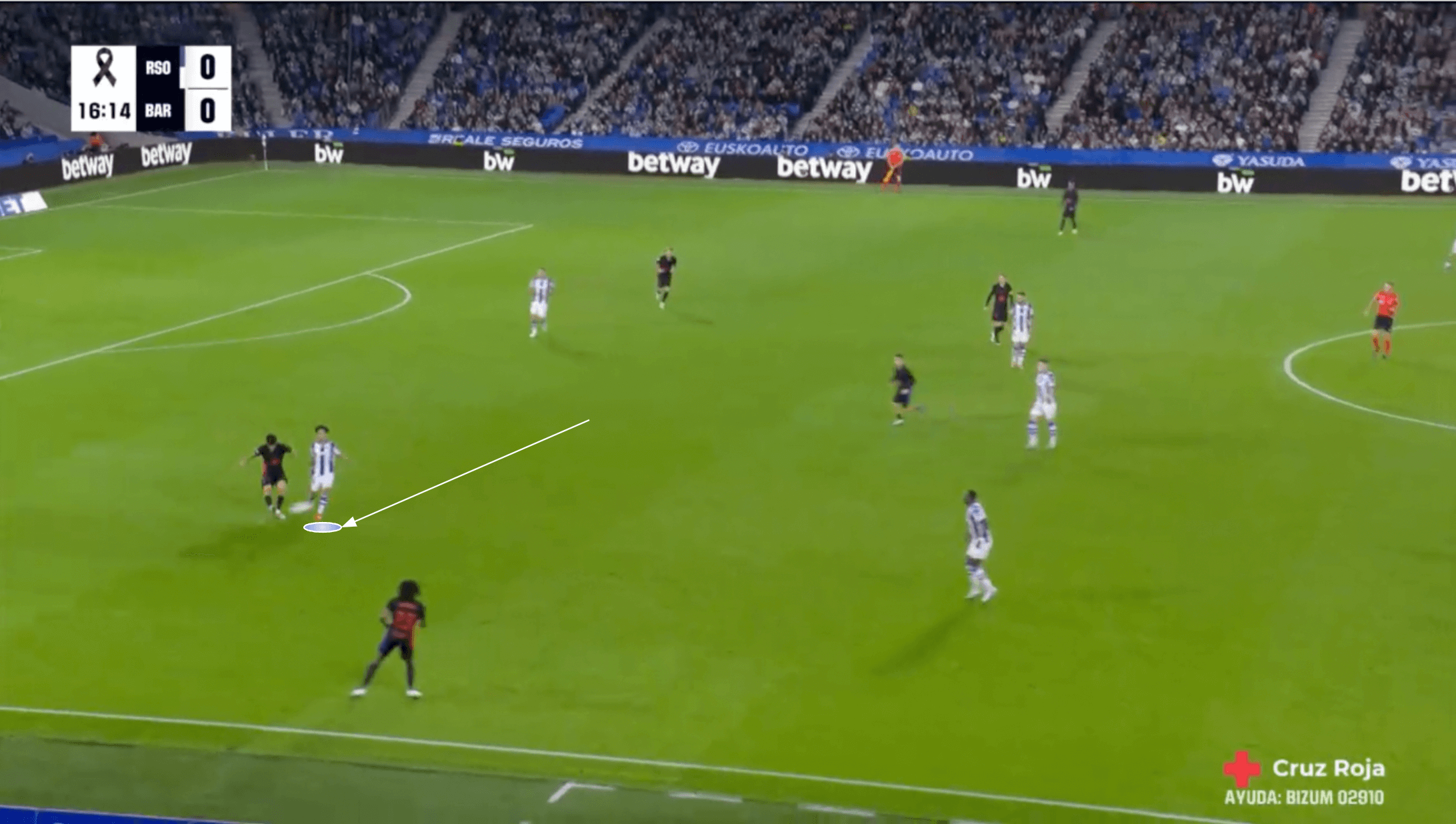
In another instance, Kubo closes down right centre-back Cubarsí, again forcing a Barca defender into a rushed move.
This time, the pass is played towards a teammate but is played far too strongly, allowing Sociedad to regain possession once again quickly.
There were plenty of examples like this throughout Sunday’s game, which showcased the effectiveness of Sociedad’s high pressing from the front.
It forced Barca into passing mistakes and prevented them from building any momentum.
Oyarzabal was also very active in pressing, including pressing in the mid-block when he had to track back and support his team just inside their own half.
He was typically aggressive yet fair in his tackling, and his presence was sometimes seemingly felt even before he arrived.
He influenced Barca ball carriers into negative moves, anticipating Oyarzabal’s intense arrival.
Overall, Sociedad appeared far more fired up for the midfield and build-up battles in this game, both on and off the ball, from a physical perspective, than Barcelona did, giving them a necessary edge when it came to winning duels, considering Barca’s qualitative advantages.
Real Sociedad’s Central Man-Orientation
Another critical aspect of Sociedad’s high-pressing approach in the middle of the park was the man-oriented nature of their central midfield players.
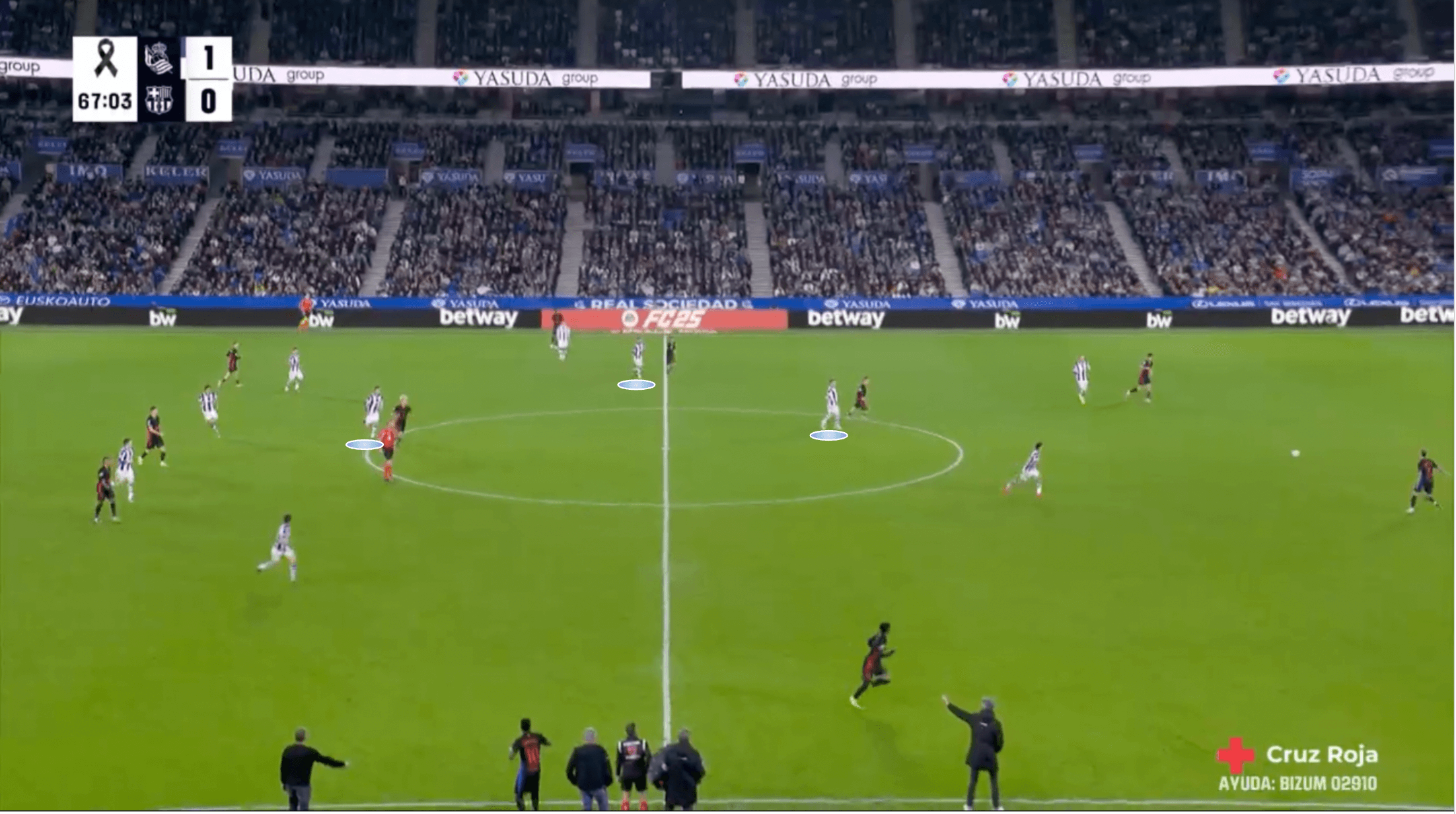
Sociedad’s holding midfielder stuck tight to Barca’s ‘10’, while their left and right central midfielders kept close to their opposite numbers as well.
This led to the scene we observe in Figure 7 above being a pretty common sight throughout the game.
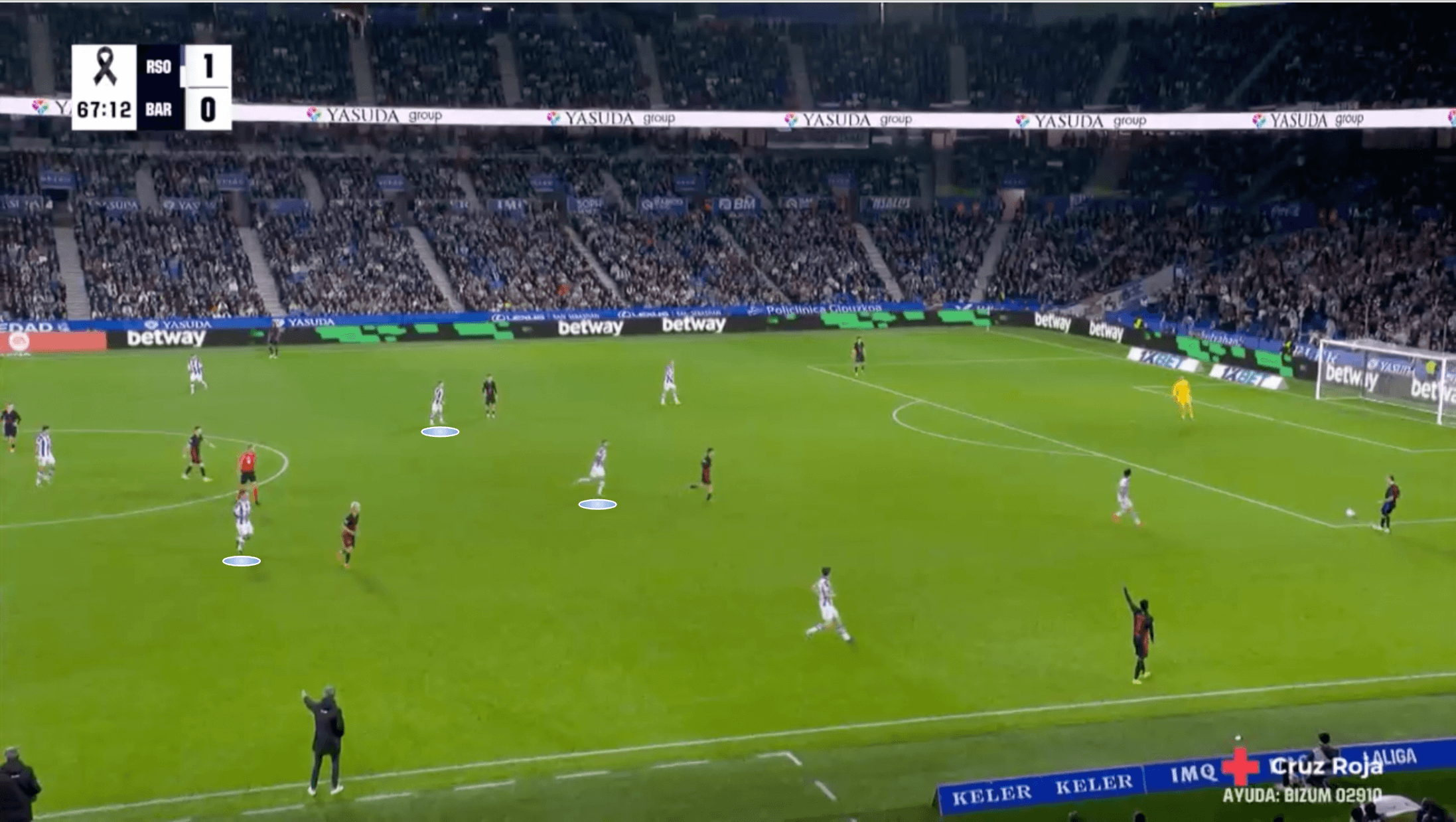
As Barca’s midfield pairing switches sides, they’re closely followed by the same Sociedad men who do the same, switching from left to right and vice versa.
Even as Olmo drifts wider, Sociedad’s holding midfielder sticks with him diligently.
This does open space up centrally for Barca to potentially exploit, but the context of this play makes that space quite challenging to target in this instance.
Barca struggled to get their midfielders involved due to the high-pressing forwards and man-oriented central midfielders used by Sociedad.
Throughout the game, as their poor attacking statistics indicate, Barca failed to find solutions for the problems Sociedad presented in terms of their pressing approach.
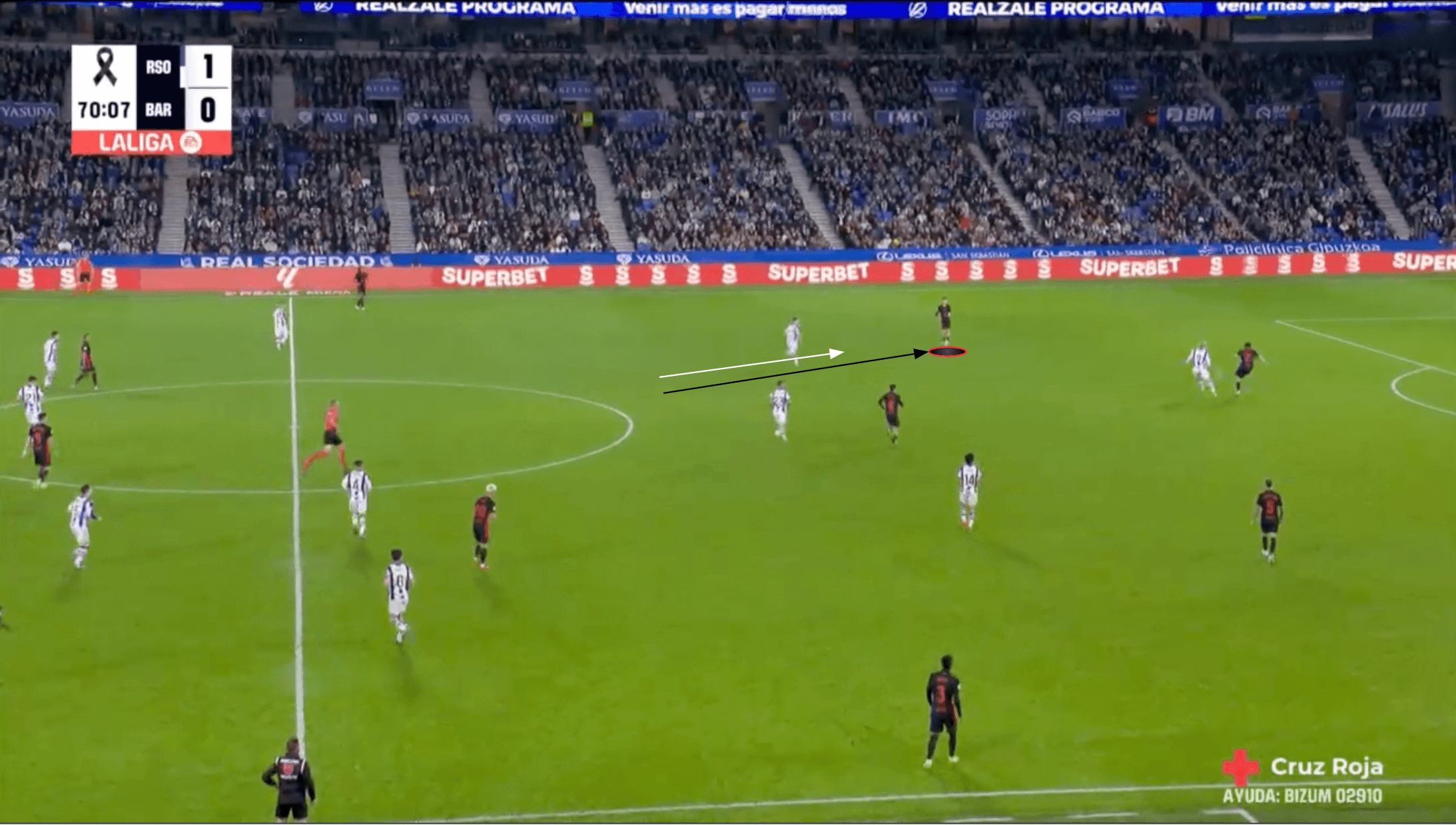
Barca’s midfielders very rarely dropped into the backline versus Sociedad.
We saw one instance of Casadó dropping in during the second half, shown in Figure 9.
As you might expect, his man-marker follows him, which opens up space centrally for Barca to potentially exploit.
However, nobody targets this space with their movement, and this attack ends up petering out.
Throughout the game, Barca failed to exploit Sociedad’s weaknesses, especially those of its man-oriented central midfielders. It also failed to move the ball around at a fast enough tempo, in combination with intelligent off-the-ball movement, to cause Alguacil’s side significant problems.
Real Sociedad’s Backline
We’ve discussed the forwards and midfielders, so let’s move on to Real Sociedad’s backline and their role in the team’s defensive tactics, which toppled Barcelona on Sunday.
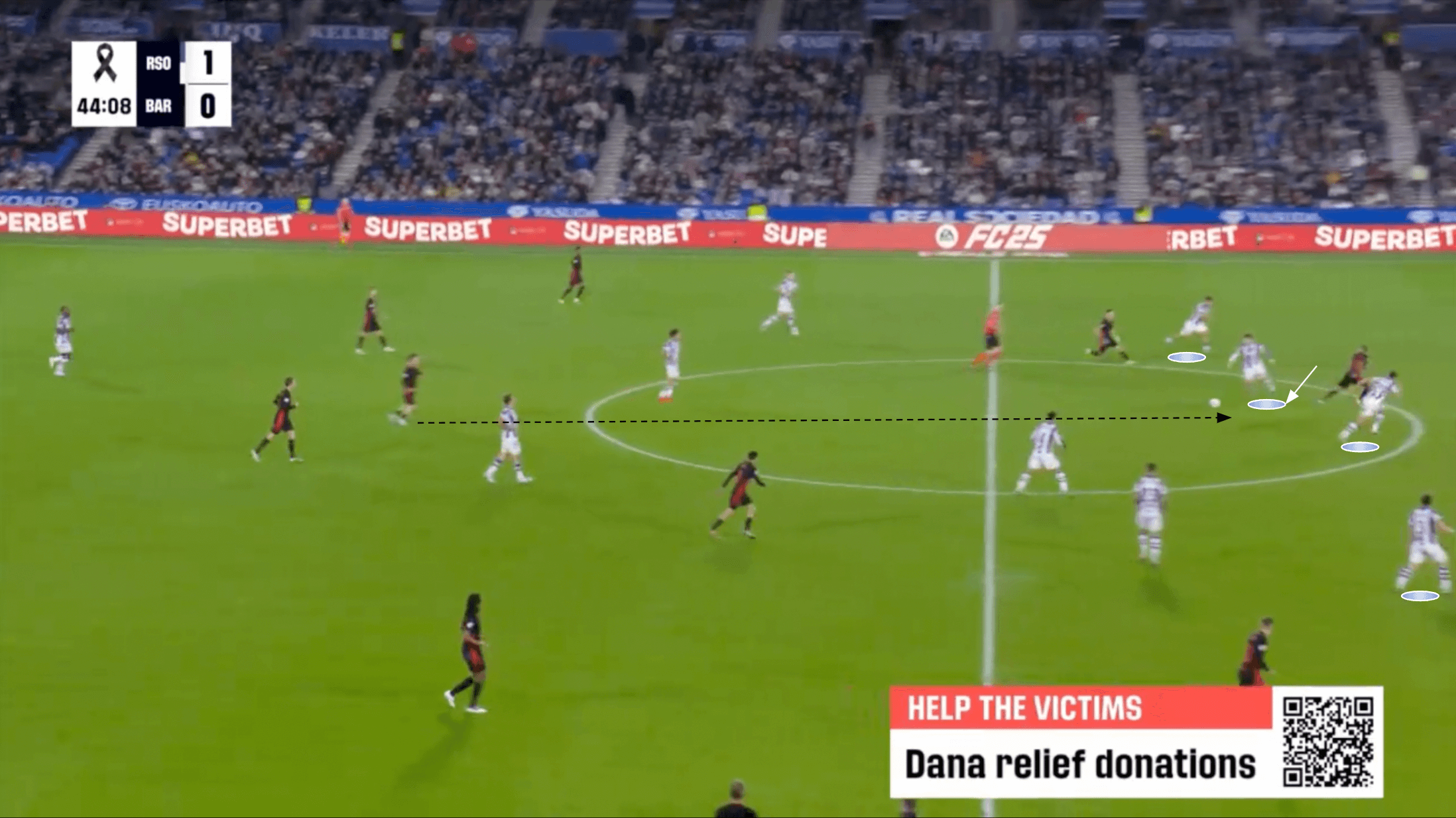
While pressing high, it was primarily the responsibility of Sociedad’s wingers to deal with Barca’s full-backs.
It wasn’t until the ball was played beyond them, towards the wingers, that Sociedad’s full-backs would get involved in the high press.
Sociedad’s wingers might even take responsibility for Barca’s wingers in the mid and low-block phases, allowing the Basque side’s back four to remain horizontally compact.
This level of horizontal compactness, as observed between the four members of Sociedad’s backline in figure 10, was crucial to their success in keeping Barca quiet on Sunday.
They positioned themselves quite closely to one another, giving Barca very little room to aim for should they get into a position where they could think about breaking Txuri-urdin’s backline.
This, together with good coordination between Alguacil’s defenders and solid defensive ability from the defenders themselves, such as the anticipation and timing on display from Zubeldía above, helped make Sociedad’s backline impenetrable for Flick’s side at the weekend.
Nayef Aguerd & Igor Zubeldia Defensive Territory Map
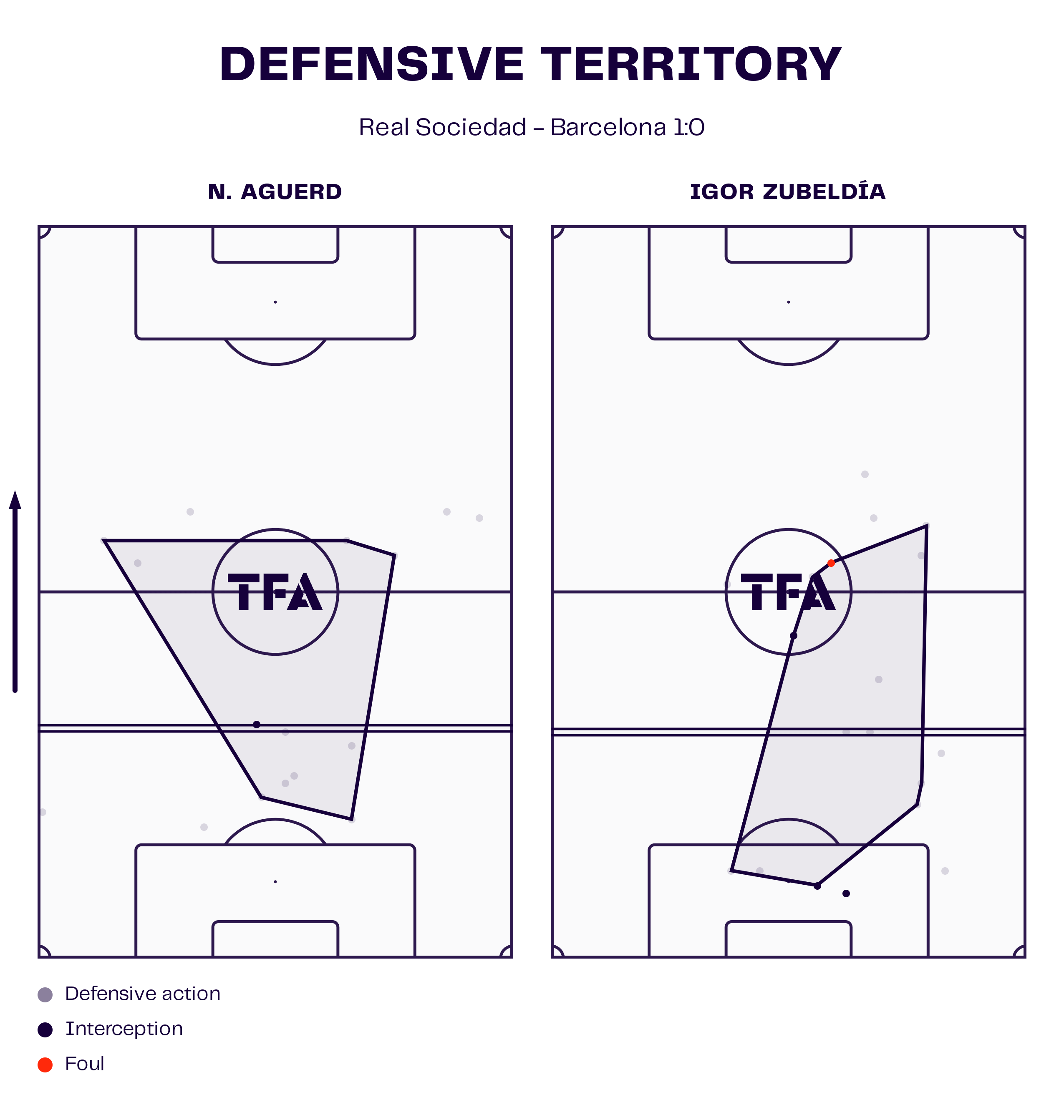
Both of Txuri-urdin’s centre-backs, Nayef Aguerd and Igor Zubeldia, were highly active in this game.
Both were required to show their abilities defending high and deep, with Zubeldia’s box defence in particular coming in clutch for Sociedad.
Often, Zubeldia was required to use his recovery pace to get in between the ball and Barca runners in behind coming from the left, who were frequently targeted by deep passers.
He was well up to the challenge and played a vital role in his team’s victory.
Conclusion
To conclude this tactical analysis of Real Sociedad versus Barcelona, we can clearly see how Flick’s Barca struggled to create versus the high press of Alguacil’s Real Sociedad.
Sociedad’s aggressive forwards, man-oriented midfielders, and highly organised backline all played unique but vital roles in the overall defence, keeping one of Europe’s in-form teams quiet on Sunday—a big tactical victory for Sociedad and their 53-year-old manager.





Comments